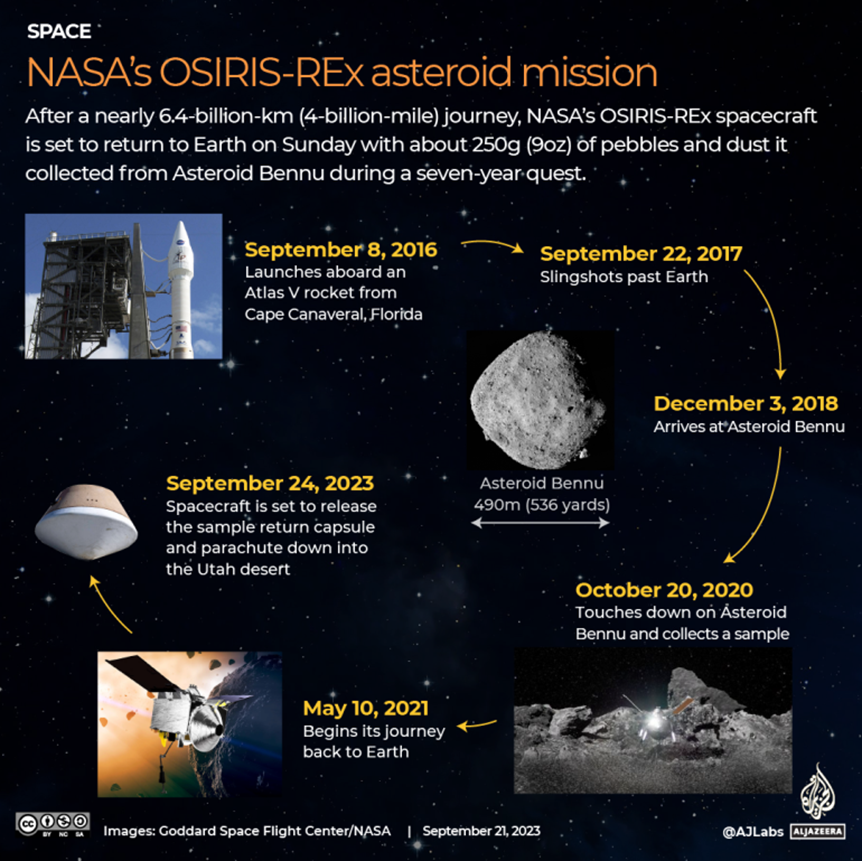ASTEROID BENNU SAMPLE BOOSTS ET LIFE THEORY
Relevance: GS 3 – Awareness in the fields of IT, Space, Computers, robotics, nano-technology, biotechnology and issues relating to intellectual property rights.
Why in the News?
- Recent findings from the study of the asteroid Bennu suggest life-forming processes are active throughout the universe.
- The discovery supports the theory that extraterrestrial life likely exists.
- This challenges the notion that life is exclusively unique to Earth.
Panspermia Theory Supported by Bennu Samples
- Samples from asteroid Bennu brought to Earth contain building blocks of life.
- This discovery strengthens the theory of panspermia.
- Proposed by Richter in 1886 and endorsed by Svante Arrhenius in 1908.
- Panspermia suggests life exists throughout the universe and is spread by space dust, meteoroids, asteroids, and comets.
- Origins of Life on Earth:
- Panspermia theory proposes life did not begin on Earth.
- Instead, life’s building blocks were introduced to Earth by cosmic ‘carriers’ crashing into the planet.
Asteroid Bennu’s Potential Impact
- The probability of asteroid Bennu crashing into Earth is estimated at 1 in 2,700.
- NASA’s OSIRIS-Rex Mission:
- Launched in 2020, the OSIRIS-Rex mission reached asteroid Bennu.
- Samples from Bennu were collected and stored in a protected capsule.
- The capsule was precision-dropped in the Utah desert, USA, on September 24, 2023.
- Detailed Analysis of Bennu Samples:
- Initial studies of the samples indicated the presence of life’s building blocks.
- A clearer understanding was obtained from findings presented at the Lunar and Planetary Science Conference in Texas.
- The samples from Bennu contain:
- Glycine: Recognized as the simplest amino acid and a crucial component of proteins.
- Water-bearing Minerals:
- Magnetite
- Sulphites
- Olivine
- Carbonates
- These minerals are considered essential components of life’s building blocks.
Hayabusa-2 Mission and Ryugu Samples:
- In December 2020, the Japanese spacecraft Hayabusa-2 returned to Earth.
- It had collected samples from the near-Earth asteroid, Ryugu.
- In March 2023, scientists announced the findings from these samples:
- Organic Compounds: Presence of uracil, a component of ribonucleic acid (RNA), and vitamin B3.
- Carbonated Liquid Water: Found in one crystal, which also contained salts and organic matter.
Lord Kelvin’s 1871 Theory
- Lord Kelvin, known for significant discoveries such as the Kelvin temperature scale and the second law of thermodynamics, presented a theory in 1871.
- At a gathering of the British Association for the Advancement of Science, he suggested that meteorites could have carried the seeds of life to Earth.
- This theory posited the possibility of life’s origins being extraterrestrial, brought to our planet through celestial bodies.
- Murchison Meteorite Discovery (1969)
- In September 1969, a meteorite exploded over Murchison town, north of Melbourne, Australia.
- Analysis of the meteorite revealed:
- It carried 74 types of amino acids.
- Eight of these amino acids are known to be involved in the formation of earthly proteins.
Latest Findings and Implications
- Recent discoveries further support the idea of life-forming processes being active throughout the universe.
- This suggests:
- Extraterrestrial life is likely to exist.
- Life is not an exclusive or erratic domain of Earth.
- It challenges the notion of Earth being the only inhabited planet, indicating that life might be more widespread in the vast universe.
| What are asteroids?
Asteroids are small, rocky objects that orbit the Sun. They are remnants from the early formation of our solar system, over 4.6 billion years ago. Most asteroids reside in the asteroid belt, a region located between the orbits of Mars and Jupiter. However, some can be found in other locations in the solar system, including near-Earth space. Key characteristics: ● Composition: ○ Most asteroids are composed of rock and metal, similar to the composition of the Earth’s crust. ○ Some asteroids, known as carbonaceous asteroids, are rich in carbon and contain organic compounds and water. ● Size: ○ Asteroids vary greatly in size, ranging from a few meters to hundreds of kilometers in diameter. The largest asteroid, Ceres, is about 940 kilometers (about 584 miles) across. ● Shapes: ○ Asteroids can have irregular shapes due to their small size and weak gravitational forces. ● Orbits: ○ The majority of asteroids orbit the Sun in the asteroid belt, but some have orbits that bring them closer to Earth. ● Impact Hazards: ○ Asteroids that come close to Earth and are large enough can pose a potential impact hazard. The Earth has been struck by asteroids and comets in the past, leading to mass extinction events and significant geological changes. ● Types: ○ There are different types of asteroids based on their composition and appearance, including: ○ C-type (carbonaceous) asteroids: Dark in color and rich in carbon. ○ S-type (silicaceous) asteroids: Brighter and mainly composed of silicate rocks and nickel-iron. ○ M-type (metallic) asteroids: Made up primarily of nickel-iron. ● Exploration: ○ Several spacecraft have been sent to study asteroids up close, such as NASA’s Dawn mission to the asteroid Vesta and the asteroid belt’s largest object, Ceres. ○ Japan’s Hayabusa and Hayabusa2 missions successfully returned samples from asteroids, providing valuable insights into their composition and history. ● Trojan Asteroids: ○ They are located in stable regions known as Lagrange points, where the gravitational forces of the planet and the Sun balance out. |
Source: https://www.newindianexpress.com/editorials/2024/Mar/22/asteroid-bennu-sample-boosts-et-life-theory
Mains question
Discuss the theories of panspermia and the recent findings from asteroid samples, highlighting their implications on the existence of extraterrestrial life and the origins of life on Earth. (250 words)




